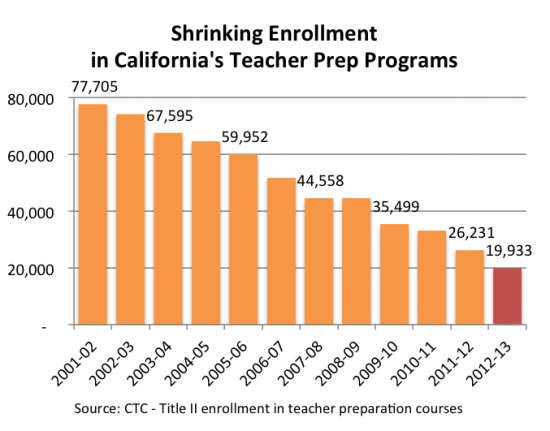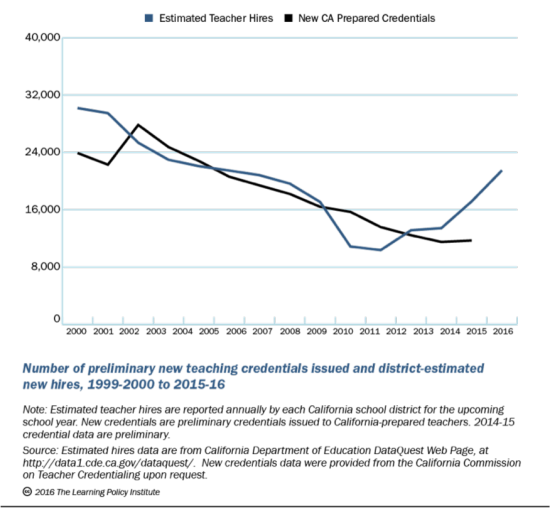This is Lesson 3.2 from the Ed100 curriculum
Ed100.org has an optimistic purpose: to help you learn how education really works, so you can make a difference – whether you are a parent, a student, a teacher, or an interested citizen. Change happens. People who are prepared and informed can take moments of change and give them meaning. Ed100 can help you learn what you need to know. About Ed100
California’s Commission for Teacher Credentialing reports annually to the California legislature about the future supply of teacher candidates.

This year, the training pipeline has largely run dry.
3.2 Preparation and Certification: How To Make a Teacher
Here’s what a teacher’s credentials can tell you.

Image: CC-NC by MTSOfan
In California, about 80% of teachers earn their credentials through the CSU systemAbout 80% of California’s teachers earn their credentials through the California State University (CSU) system, usually through a four- or five-year course of study. The rules for credentials are set by a combination of legislation and policies of the Commission on Teacher Credentialing (CTC). The CTC authorizes colleges and universities to offer teacher credential programs in a variety of grade-level and content areas, and for special student populations such as English learners and students with disabilities. Once an institution is accredited, it is responsible for quality control related to student admissions, course content, rigor, and candidate assessment.
Alternative paths to a credential
In addition to attending universities, teachers may obtain credentials through alternative credential providers, or may work in the classroom as interns. The Federal No Child Left Behind Act (NCLB) established in law the expectation that all teachers should be “highly qualified.” In 2010 the education press headlines were consumed for a time with the comical-but-deadly-serious question of under what conditions “intern” teachers could be regarded as “highly qualified” under NCLB.Having a strong pool of teaching candidates is a concern in California. California’s Commission for Teacher Credentialing reports annually to the California legislature about the future supply of teacher candidates, based on enrollments in teacher preparation programs of any kind. As of 2013, the training pipeline had largely run dry, perhaps largely because candidates understood the job market. Why enroll to become a teacher if the jobs aren’t going to be there at the end of the program?

There is every reason to expect that enrollment in teacher prep programs will show improvement when data for the recovery years after 2013 become available. (Education data, like many other kinds of government data, is delivered by tortoises with a delay of about three years; analysis of the data can take even longer.) Demand and supply are cyclical, and frequently out of alignment: demand can arrive suddenly, with a budget increase, but teacher prep programs cannot respond as quickly. It takes time to recruit and train instructors, secure space, enroll prospective teachers and train them. A 2016 report from Linda Darlng-Hammond, Roberta Furger, Patrick M. Shields, and Leib Sutcher, Addressing California’s Emerging Teacher Shortage: An Analysis of Sources and Solutions (Palo Alto: Learning Policy Institute, 2016) sheds light on the shortage.

Faster certification options
Not all teacher preparation programs are lengthy. Teach for America (TFA), which recruits and certifies more teachers than any other organization in America, started by recruiting top students from selective colleges. Its training program is famously short: in contrast to the usual two-year program offered by education schools, the TFA program lasts only a few weeks. A number of studies, but not all, indicate that Teach for America’s elite rookies perform as well and sometimes better than graduates of longer programs, particularly for middle and high school math. In 2014, TFA announced changes to its training program to provide more extended support for their teachers.Communities want teachers who understand their children, including strengths, challenges and culture that they bring with them to school. Based on that, some energy and funding has gone into creating “grow your own” approaches to teacher recruitment and education. One example is the California Teacher Pathway program, which identifies young people from low-income neighborhoods who show a passion for teaching. The program is designed to support them in a variety of ways from the time they enter a community college until they earn their teaching credential, with the hope they will stay in their home community and teach.
Do these credentials matter?
Oversimplifying greatly, there are two schools of thought about teacher credentials: less is more, and more is more.- The “more is more” school argues that credentials are vital: they should be hard to get, and narrowly defined. This point of view was generally ascendant in the first decade of the 21st century, partly driven by the requirement of the No Child Left Behind Act (NCLB) that every teacher be certified as “highly qualified.” It takes several years to obtain a teaching credential through normal channels, and teacher credentials became increasingly subject specific when the meaning of “highly qualified” was hotly debated. The rationale for such credential requirements is to protect children from unqualified teachers.
- The “less is more” reformers argue that teaching is a skill more general than the subject matter being taught. In this view, complex credential requirements do more to deter good people from teaching than they do to weed out unprepared candidates. These reformers look to speed the path to a credential for those with the right stuff. Perhaps the most pure example of this concept is the recommendation of the Education Excellence committee that county superintendents should have the authority to write credential waivers for individuals, but should lose that authority if the teachers they waive into the classroom fail to perform to expectations. (The recommendation, made at a time when the supply of teacher candidates was ample, might surface again when supply is tight.)
In 2010, a scathing report argued that many teacher preparation programs lack rigor.In 2010, a scathing report of the National Council for the Accreditation of Teacher Education (NCATE) argued that many teacher preparation programs lack rigor. The report called for sweeping changes in accreditation of teacher preparation programs to make them more relevant. Others, in contrast to the NCATE report, argue that the best course is to make the training program as short and inexpensive as possible in order to invest the savings in support of new teachers on the job.
In 2013, the National Council for Teacher Quality (NCTQ) evaluated teacher preparation programs in California. The state was graded a D, up from a D- the prior year. The Association of Colleges of Teacher Education (yes, there really is an association for everything in education) collected objections to the low grade.
Partly in response to this national conversation, California’s CTC convened a high-profile advisory panel in 2013, which generated a thick report with forty recommendations for change.
Join the Discussion
- How can teacher preparation programs make sure they admit the “best and brightest”?
- To what extent can alternative approaches to teacher recruitment and certification, such as Teach for America, influence the caliber of people who enter the profession?
- Ask teachers you know: what did they think of the certification process?
- Where did the teachers in your school earn their certification?


No comments:
Post a Comment